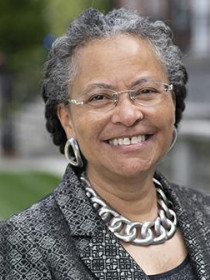
Camara Phyllis Jones
Connect with Camara
About Camara
Jones' research focuses on social epidemiology, research methods, social determinants of health, and anti-racism. Overarching themes in Jones' writings include naming, measuring, and addressing the impacts of racism on health and well-being.
Contributions
In the News
Publications
Finds an agreement of socially assigned race with self-identified race/ethnicity varied across the racial/ethnic groups currently defined by the United Statesgovernment.Included among those usually classified by others as White were 26.8% of those who self-identified as Hispanic, 47.6% of those who self-identified as American Indian, and 59.5% of those who self-identified with more than one race.
Builds on work examining the impacts of racism onhealth to identify parallels and intersections with regard to able-ism and health. The"Cliff Analogy"framework for distinguishing between five levels of health intervention is used to sort the Healthy People 2020 goals onDisability and Health along an array from medical care to addressing the social determinants of equity.
Presents a theoretic framework for understanding racism on 3 levels: institutionalized, personally mediated, and internalized. This framework is useful for raising new hypotheses about the basis of race- associated differences in health outcomes, as well as for designing effective interventions to eliminate those differences.
Presents a "Cliff Analogy" illustrating three dimensions of health intervention to help people who are falling off of the cliff of good
health: providing health services, addressing the social determinants of health, and addressing the social determinants of equity. In the terms of the analogy, health services include an ambulance at the bottom of the cliff, a net or trampoline halfway down, and a fence at the top of the cliff.
Calls public health researchers and practitioners to name racism, ask how is racism operating in their field, and organize and strategize to act. It includes a framework for an Anti-Racism Collaborative as a platform for organizing this work going forward.
Introduces the projection methods for describing and testing the differences between pairs of continuous distributions. These methods include the projection plot, the projection spline, and the iter-1 test. The projection plot displays the difference between corresponding quantiles against the average of the corresponding quantiles.